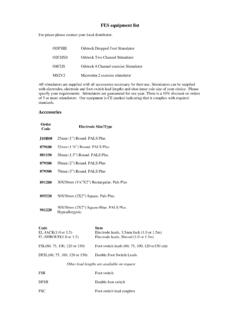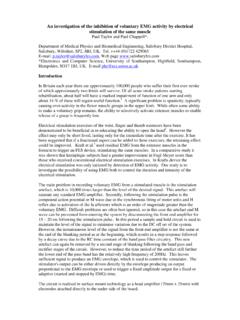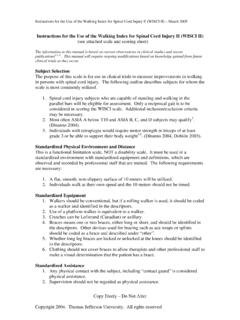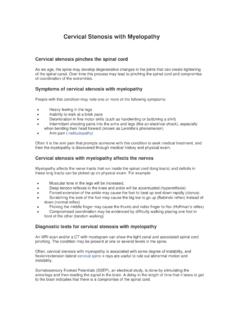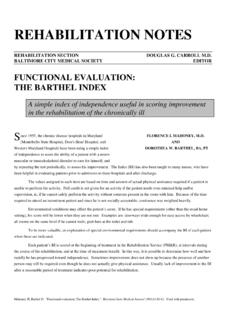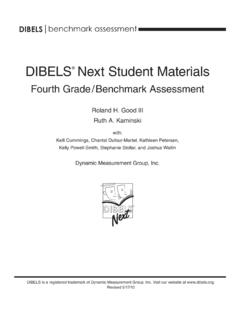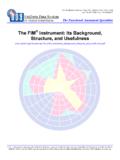Transcription of clinical guide v5 - Salisburyfes.com
1 MedicalFESI ntroductionProductsClinical Electrical Stimulation (FES)FES is a technique used to produce contractions in paralysed muscles by theapplication of small pulses of electrical stimulation to nerves that supply theparalysed muscle. The stimulation is controlled in such a way that the movementproduced provides useful function. FES is used as an orthosis to assist walking andalso as a means of practising functional movements for therapeutic Medical provides a range of neuromuscular stimulators designed toimprove the functional ability of people with a neurological condition. The deviceshave been developed over many years of collaboration between clinical engineers,clinicians and patients at the National clinical FES Centre, Salisbury District devices are suitable for use by physiotherapists and other clinicians in routineclinical can use FES?
2 For FES to be effective both the nerve and the muscle supplied by the nerve must beundamaged. For this reason FES can be used in condition such as: Stroke Multiple sclerosis (MS) Spinal cord injury, T12 and above (SCI) Parkinson's disease Cerebral palsy (CP) Head injury (HI) Familial or hereditary spastic paraparesis (FSP)In these conditions paralysis is due to an upper motor neurone lesion. FES can alsobe used in orthopaedic conditions where muscle weakness is due to disuse is not suitable for lower motor neurone conditions such as: Peripheral nerve lesions Polio Motor neurone disease Guillain-Barre SyndromeOdstock Medical LimitedOdstock Medical was established as a NHS owned spin off company by SalisburyNHS Foundation Trust in April 2006.
3 The company was formed to exploit thesuccess of the FES work carried out by the Department of Medical Physics andBiomedical Engineering at Salisbury District Hospital over the previous 20 company aims to continue the development of FES and provide the higheststandards of clinical service to the NHS. The new commercial status will enableexpansion and will ensure as many people as possible can benefit from thetechniques and technology developed in - Odstock Dropped FootStimulatorThe Odstock Dropped Foot Stimulator (ODFS) is a single channel, foot switchcontrolled stimulator designed to correct dropped foot in upper motor neuroneconditions. Skin surface electrodes are placed, typically over the common peronealnerve as it passes over the head of the fibula and the motor point of tibialis produces dorsiflexion and eversion of the foot and in certain electrodeconfigurations produces a withdrawal reflex, adding knee and hip flexion.
4 The riseand fall of the stimulation can be adjusted to prevent a sudden contraction that mightinduce a stretch reflex of the calf muscles. There are also facilities to add anextension to the stimulation envelope after heel strike, mimicking the natural activityof the anterior tibialis muscle, which contracts eccentrically to lower the foot to theground and stabilises the ankle at initial and eversion in swing phase of gait produces: Improved ground clearance Reduced tripping and falls Reduced compensatory activity Reduced effort of walking Reduced spasticity Increased walking speed Heel strike with eversion improved loading response greater stability in stance Greater range of mobility Greater safety, confidence and independence while walking Long term therapeutic benefit Greater social interaction and improved quality of lifeThe ODFS's main application is as a long term mobility aid.
5 However the ODFS canalso be used in gait re-education following stroke and spinal cord injury. Typicalminimum ability to use the ODFS is to be able to stand from sitting unaided and walk10m or more with appropriate aids or assistance from another person. EvidenceThe ODFS was subject of a randomised controlled trial (RCT) that showed thatchronic stroke patients walked 16% faster with the device with a reduction ofphysiological cost index (an estimate of the effort of walking) of 29%1. The FESgroup also showed a reduction in quadriceps spasticity and a reduction in anxietyand depression. QALY analysis (Quality Adjusted Life Years) indicated a significantpositive cost / benefit from the treatment2. The trial results together with case seriesdata from subjects who had MS, were presented to the South and West RegionalHealth Authority Development and Evaluation Committee3 who recommended theODFS for use in the UK's National Health Service for patients with upper motorneurone lesions (1996).
6 A subsequent audit of clinical service over the first 18 weeks of use confirmed theresults of the original RCT and also showed a significant training effect animprovement in walking ability when not using the stimulator, in a group of 111 strokesubjects4. Overall, users walked 27% faster when they used the device with atraining effect of 14%. In a subgroup of 27 ODFS users walking speed both with andwithout the device was observed to improve over the first 18 weeks and thereafterremain unchanged. As the ODFS users were an average of (sd ) yearspost stroke, this supports the hypothesis that the training effect observed was due tothe use of the stimulator rather than natural recovery following the stroke. In a groupof 78 MS subjects, users walked 20% faster when using the device5.
7 However, notraining effect was observed. In a subgroup of 20 MS users, this improved walkingspeed with the device was shown to also peak at 18 weeks with no significantchange from initial values after that time, indicating the ODFS is an effective % change in walking speed for stroke (n=27) and MS (n=20) ODFS users-10010203040506001020304050607080 Weeksmean % change from initial unaided walking speedStroke ODFSS troke unaidedMS ODFSMS unaidedMean initial unaided walking speedStroke = m/sMS = m/sA questionnaire survey indicated that the most common reasons for using the ODFS were that it reduced the effort of walking, reduced tripping and improved confidencewhile walking6. Compliance with treatment was 92% at 18 weeks and 86% at 1year7. In the year 2000 the device was recommended by the Royal College ofPhysicians in their publication "National clinical Guidelines on Stroke" x te n s io nR is in gE d g eR a m pF a lling E d g eR a m pH e e lR is eH e e lS trik eOutput intensityTim eFeaturesOutput: Asymmetrical or symmetrical biphasic voltage driven amplitude: 20 to 100 mA asymmetrical biphasic output 20 to 80 mA symmetrical biphasic outputFrequency: 40 width: 7 to time: to 6 time: 0 to s Rising edge ramp time: 0 to 2 edge ramp time: 0 to 2 triggering:Heel rise or heel strike (foot switch on contralateral side)Adaptive or fixed timingIntelligent footswitch:The sensitivity adapts to the weight of the :Easy to use amplitude control, test and pause switchesLow battery indication Battery.
8 PP3, standard 9V alkaline or rechargeable batteryWeight (with battery):143gmDimensions: 95 x 61 x 26 mm (excluding controls and belt clip)Approvals:CE marked and FDA approved. ODFS users comments The stimulator has become a necessary part of me and makes my life a lot easier. Idon t avoid walking now and I feel far more confident. I haven t fallen using thestimulator, so it s taken the fear of doing a lot of damage away. I m now starting towiden my scope of activity quite dramatically. In fact, I think it is a fabulousimprovement and I m delighted with it. K. D. 11th May 2004 I would say that with the stimulator it s half the effort to walk. I find I enjoy thingsmore and I am far more conscious of where I am because I do not have to thinkabout getting my foot in front of the next one all the time.
9 It gives me more freedomand more independence. I ve even gone for a walk by myself. It s certainly nice to beback in the real world again. G. M. 14th April - Odstock Two ChannelStimulatorThe O2 CHS is a 2 channel foot switch controlled stimulator designed to assistdropped foot and other gait problems following an upper motor neurone lesion. It hasthe same facilities as the ODFS with additional features to control the interaction ofthe two channels. The following combinations of muscles can be stimulated:Stimulated muscles /groupsConditionsProblem addressedBilateral dorsiflexionMS, FSPand CPbilateral dropped footDorsiflexion with hamstringsStroke andMSDropped foot with reduced knee flexionDorsiflexion with glutealmusclesStroke andMSDropped foot with hip flexion / adduction instanceDorsiflexion with quadricepsIncompleteSCID ropped foot with quadriceps weaknessDorsiflexion with calf musclesStroke, MS,CP etcDropped foot and lack of push off in terminalstanceDorsiflexion with triceps foot with strong associated reactionin the upper limbBilateral erectispinie / glutealmusclesSCI, FSPT randelenburg gaitBilateral quadricepsSCI.
10 FSPQ uadriceps weaknessThe timing of muscle activation can be adjusted so that a contraction can occur asweight is transferred on or off a footswitch or set to occur at other times in the gaitcycle by adding a delay following a footswitch transition. The device is used as anorthotic aid, replacing conventional splinting and also as a training device assistinggait EvidenceThe most common use for the O2 CHS is for correction of bilateral dropped foot. Anaudit of 18 people with MS showed that walking speed increased by a average of48% with the device after 18 week use7. A second audit of stroke and MS patientsusing gluteal muscle stimulation with common peroneal stimulation demonstratedfurther increases in walking speed when the hip extensors were added9. Gains inwalking speed was also demonstrated when knee flexors or plantaflexors wereadded to common peroneal x te n s io nE x te n s io nR is in gE d g eR a m pR is in gE d g eR a m pF a lling E d g eR a m pF a lling E d g eR a m pH e e lR is eH e e lR is eH e e lS tr ik eOutput intensityTim eD e la yC h annel 2C h annel 1B ila te r a l D ropped FootFeaturesOutput: Asymmetrical or symmetrical biphasic voltage amplitude: 20 to 100 mA asymmetrical biphasic output, 20 to 80 mA symmetrical biphasic : 20 to 60 width: 7 to times: to 6 times: 0 to sDelay time (Ch.)

